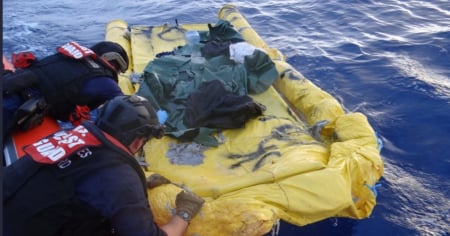
Related videos:
The National Weather Service of Miami (NWS) warned that this weekend there is a high risk of rip currents at beaches along the southern Atlantic coast of Florida.
In an official statement issued this Sunday, the authorities clarified that the risk of rip currents is over 50%.
The coastal areas of Palm Beach, Broward, and Miami Dade should pay attention to this eminent danger: "Currents can pull even the best swimmers into deeper waters," warned the NWS.
"Dangerous conditions continue at the beaches: Attention to bathers on the Atlantic coast. There is a high risk (more than 50%) of rip currents along the beaches of the Atlantic in South Florida throughout the weekend," the National Weather Service in Miami wrote in a message on X.
According to experts, rip currents are fast and narrow water channels that move away from the shore.
They can go unnoticed, as they often occur when the weather is fine.
This weekend, after the buildup of high pressures, wind speed has increased, and as a result, the danger at sea has heightened.
That's why Florida authorities advised swimmers to stay close to a lifeguard and added: "If you get caught in a current, relax and float. Do not swim against the current. If possible, swim toward the shore. If you cannot escape, look toward the shore and ask for help."
Rip currents have resulted in dozens of deaths on Florida beaches.
In 2023, there were a dozen drowning deaths due to rip currents at beaches in that state, where there were not enough lifeguards to prevent swimmers from entering the water, despite the red flag warnings.
Some of the most beautiful beaches in the United States, stretching from the Panhandle to the Alabama border, have also been some of the deadliest.
Seven of the 12 deaths occurred in Panama City Beach, and all the fatalities were men aged between 39 and 68 years.
Frequently Asked Questions About Rip Currents on the Beaches of South Florida
What is a rip current and why are they dangerous?
Rip currents are narrow, fast channels of water that pull away from the shore and can drag swimmers into deeper waters. They are dangerous because they can be hard to detect and are responsible for many drowning deaths at beaches, as even the best swimmers can be swept away by them.
How can I identify a rip current at the beach?
You can identify a rip current by looking for differences in water color or areas where the waves don’t break uniformly. These areas may appear calmer, but in reality, they indicate the flow of a current pulling water offshore. It is advisable to avoid entering the water if you observe these signs.
What should I do if I get caught in a rip current?
If you find yourself caught in a rip current, stay calm and do not fight the current. Swim parallel to the shore until you are out of the current. If you can't escape, float and signal to attract the attention of lifeguards or nearby individuals.
What safety measures should swimmers follow during the weekend?
During the weekend, it is important for swimmers to swim near a lifeguard and avoid swimming alone. Additionally, they should pay attention to red flag warnings on the beaches and follow the safety guidelines provided by local authorities.
Filed under:





